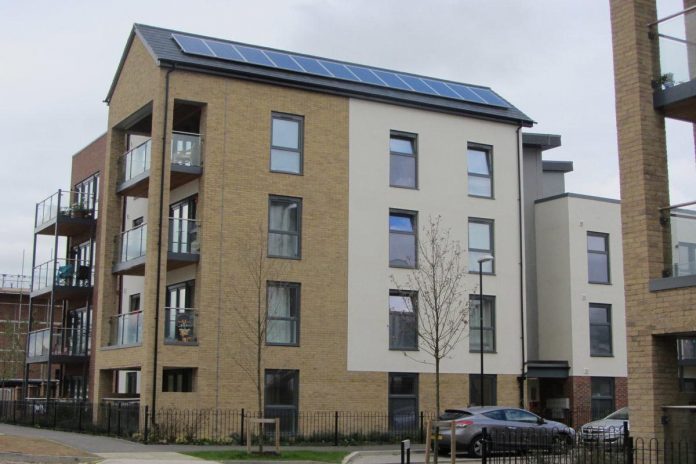National Energy Foundation energy specialist, Jane Richardson Hawkes, says carbon offsetting can help local authorities fund energy efficiency improvements
Carbon offsetting makes a significant contribution to reducing carbon emissions and meeting nationally-determined targets. It also offers opportunities for local authorities to engage with their residents on issues such as climate change and provides a mechanism for financing a range of practical energy efficiency improvements and renewables that help improve the local area and residents’ wellbeing.
How does a carbon offset fund work?
Although the detail of carbon offset schemes might vary from one local authority to another, the fundamentals are the same. Carbon offsetting applies to major new developments and the starting point is that new buildings should be built to high environmental standards.
The local authority specifies a target for carbon dioxide emissions that is above the requirement specified in Part L of the Building Regulations. Where the developer can’t achieve this on-site, carbon offsetting enables it to be met off-site. Where this is the case, Energy Statements are used to provide the anticipated level of carbon dioxide (over the target) that each ‘as-designed’ new building will emit during its first year of use. The developer then pays a set sum for each tonne over the target multiplied by the set number of years determined by the council. In the case of smaller new developments (where there’s no requirement to produce Energy Statements) the developer pays a flat fee per unit.
The offset fund is then used to finance energy-saving schemes in the local authority area and the fund is managed according to clear principles agreed by the council.
Carbon offsetting future
Despite the UK Government having rolled back on its zero-carbon buildings policies, the Mayor of London has recently applied a zero-carbon standard to major new residential developments (i.e. 10 or more units) in the capital. These homes need to achieve at least an on-site 35% reduction in regulated carbon dioxide emissions beyond Part L of the Building Regulations. The remaining regulated carbon dioxide emissions to 100% are to be offset through a cash-in-lieu contribution to the relevant borough, which is ring-fenced in order to ensure the delivery of carbon dioxide savings elsewhere.
For commercial developments, the policy objective is a 35% reduction in regulated carbon dioxide emissions beyond the Building Regulations and, where this cannot be met on-site, a cash-in-lieu contribution is levied by the appropriate planning authority.
The Mayor’s Sustainable Design and Construction provides guidance on the collection and spending of the fund, with a preference for retrofitting publicly-owned property as this provides wider community benefit. Schools, council offices, public facilities and social housing are highlighted as buildings that could be retrofit most readily. Another option is to establish a borough-wide revolving energy fund, where loans are provided to local residents or businesses wanting to retrofit energy and water-saving measures.
Carbon offsetting knowledge and experience
At the National Energy Foundation, we have worked at the forefront of carbon offset development for over a decade, most notably assisting Milton Keynes Council to establish the UK’s first carbon offset Local Plan policy (D4) in 2008.
As the council’s carbon offset manager since then, we have kept a watching brief on national and local offsetting research and policy development, and have co-ordinated a range of locally-based carbon reduction projects. The Milton Keynes scheme is highlighted as a Best Practice example in the Mayor of London’s Sustainable Design and Construction Supplementary Planning Guidance document.
So far, its trail-blazing approach has achieved carbon savings totalling more than 6,600 tonnes. It has also generated more than £1 million for targeted carbon-saving projects that have benefited local residents and helped address wider social, economic and health issues such as fuel poverty.
We have also used our experience to help Southampton City Council develop its carbon offset policy, and our work included a review and analysis of other English local authority carbon offsetting work.
In addition, we recently completed a research report commissioned by the Greater London Authority (GLA), Review of Carbon Offsetting Approaches in London, in which we undertook a London-wide assessment of the carbon offset approaches taken by the capital’s 35 local planning authorities, and an examination of their progress.
Broad knowledge and expertise enhances service provision
Providing carbon offset services is enhanced by also having knowledge and expertise in related areas such as building energy performance; energy modelling; carbon reporting, footprinting and verification; community renewables; and energy efficiency management.
This is where the National Energy Foundation can help. As a result of our long-standing experience and our recent work for the GLA, we have developed a detailed and broad understanding of all the issues around the establishment and operation of carbon offset schemes, and can provide:
- Advice and support in setting up a fund and sourcing funding.
- Support in initiating ideas, programmes and schemes to reduce carbon emissions.
- Managing and delivering a fund through local carbon-saving initiatives.
- Managing a scheme’s finances and ensuring compliance with the fund’s terms and conditions.
- Verification of any resulting carbon savings.
- Reporting to the council/Carbon Offset Board on a regular basis.
As a result, we’re well-placed to offer our top tips for setting up and running a carbon offset scheme:
- Carbon price. Don’t be too ambitious on carbon price. A modest fund can pay for more measures than no fund.
- Project management. Don’t be afraid to pay for decent project management. It’s a very important skill but one that’s often undervalued, until things go wrong! This is another area where we’ve had a great deal of experience and can help.
- Benefits. Ensure that any benefits are widely spread. Make sure that they’re not just available to those who can afford to pay but also to those who are most in need or require help to access them.
- Funding. Take advantage of LEEF and/or Salix funding to piggy-back on good projects.Additionality. This is also important. Don’t fund what would have happened anyway.
- Additionality. This is also important. Don’t fund what would have happened anyway.
- Realistic. Don’t be too optimistic. Take into account real energy-saving lifetimes and real-world savings.
- Transparency. Be transparent. Keep all your stakeholders on board.
- Measures. Concentrate on proven carbon saving measures such as:
– Boiler cashback or scrappage schemes.
– LED light bulb swaps.
– Retrofitting local authority housing stocks.
– Energy efficiency improvements to publicly-owned buildings – for example, libraries, town halls, schools and community centres.
– Subsidised wall and loft insulation.
– Landlord subsidies for energy efficiency measures.
– Improvements to communal heating systems.
– Project work on decentralised energy systems.
– Small energy efficiency measures and advice on how to use energy better for the elderly and those in fuel poverty.
Jane Richardson Hawkes
Senior Energy Specialist
National Energy Foundation

















